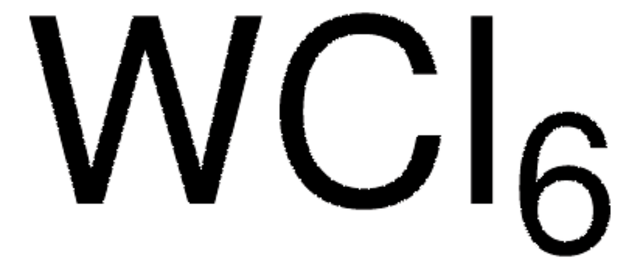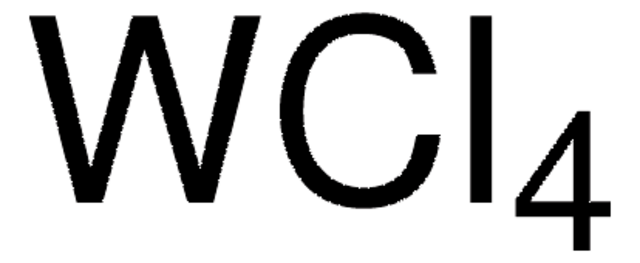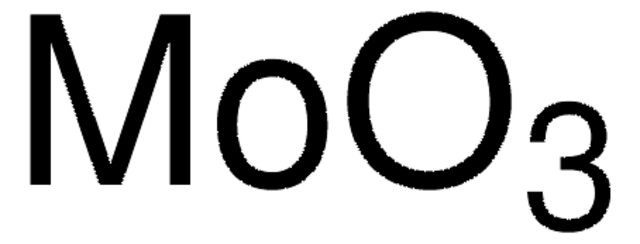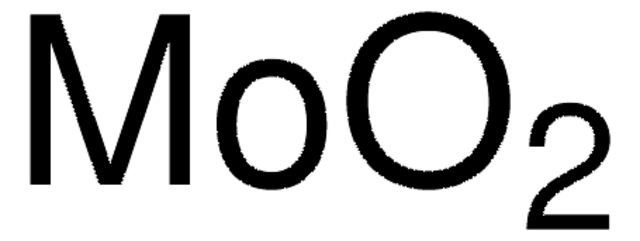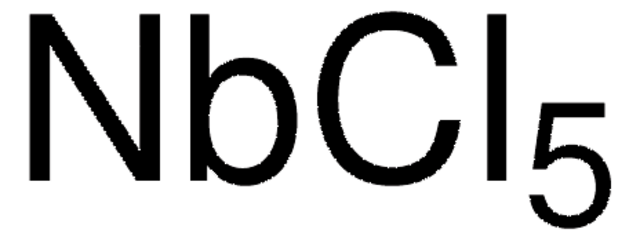642452
Molybdenum(V) chloride
anhydrous, powder, 99.99% trace metals basis (excluding W)
Sinónimos:
Molybdenum pentachloride, Molybdenum(5+) chloride
About This Item
Productos recomendados
grado
anhydrous
Nivel de calidad
presión de vapor
1.75 mmHg ( 25 °C)
131 mmHg ( 250 °C)
Ensayo
99.99% trace metals basis (excluding W)
Formulario
powder
impurezas
≤150.0 ppm Trace Metal Analysis
bp
268 °C (lit.)
mp
194 °C (lit.)
densidad
2.928 g/mL at 25 °C (lit.)
aplicaciones
battery manufacturing
cadena SMILES
Cl[Mo](Cl)(Cl)(Cl)Cl
InChI
1S/5ClH.Mo/h5*1H;/q;;;;;+5/p-5
Clave InChI
GICWIDZXWJGTCI-UHFFFAOYSA-I
¿Está buscando productos similares? Visita Guía de comparación de productos
Categorías relacionadas
Descripción general
Aplicación
- As a catalyst for amidation of secondary benzyl alcohols.
- As a precursor to fabricate MoS2 thin films by atomic layer deposition method.
- As a primary catalyst for coordination polymerization of butadiene.
- To fabricate superior anode materials for Na-ion and Li-ion batteries.
- As a dual-function redox mediator for Li–O2 batteries to overcome thehigh polarization and low energy density issues.
Para utilizar con
Palabra de señalización
Danger
Frases de peligro
Consejos de prudencia
Clasificaciones de peligro
Skin Corr. 1B
Código de clase de almacenamiento
8A - Combustible corrosive hazardous materials
Clase de riesgo para el agua (WGK)
WGK 3
Punto de inflamabilidad (°F)
Not applicable
Punto de inflamabilidad (°C)
Not applicable
Equipo de protección personal
Eyeshields, Faceshields, Gloves, type P3 (EN 143) respirator cartridges
Elija entre una de las versiones más recientes:
¿Ya tiene este producto?
Encuentre la documentación para los productos que ha comprado recientemente en la Biblioteca de documentos.
Los clientes también vieron
Artículos
Nanostructured Materials Through Ultrasonic Spray Pyrolysis
We presents an article about a micro review of reversible addition/fragmentation chain transfer (RAFT) polymerization. RAFT (Reversible Addition/Fragmentation Chain Transfer) polymerization is a reversible deactivation radical polymerization (RDRP) and one of the more versatile methods for providing living characteristics to radical polymerization.
Applying ARGET ATRP to the Growth of Polymer Brush Thin Films by Surface-initiated Polymerization
We presents an article about Copper(I)-mediated Living Radical Polymerization in the Presence of Pyridylmethanimine Ligands, and the emergence of living radical polymerization mediated by transition metal catalysts in 1995, which was a seminal piece of work in the field of synthetic polymer chemistry.
Protocolos
Sigma-Aldrich presents an article about RAFT, or Reversible Addition/Fragmentation Chain Transfer, which is a form of living radical polymerization.
We presents an article featuring procedures that describe polymerization of methyl methacrylate and vinyl acetate homopolymers and a block copolymer as performed by researchers at CSIRO.
Sigma-Aldrich presents an article about the typical procedures for polymerizing via ATRP, which demonstrates that in the following two procedures describe two ATRP polymerization reactions as performed by Prof. Dave Hadddleton′s research group at the University of Warwick.
Global Trade Item Number
| Número de referencia del producto (SKU) | GTIN |
|---|---|
| 642452-2G | 4061832729268 |
| 642452-10G | 4061833599785 |
Nuestro equipo de científicos tiene experiencia en todas las áreas de investigación: Ciencias de la vida, Ciencia de los materiales, Síntesis química, Cromatografía, Analítica y muchas otras.
Póngase en contacto con el Servicio técnico

